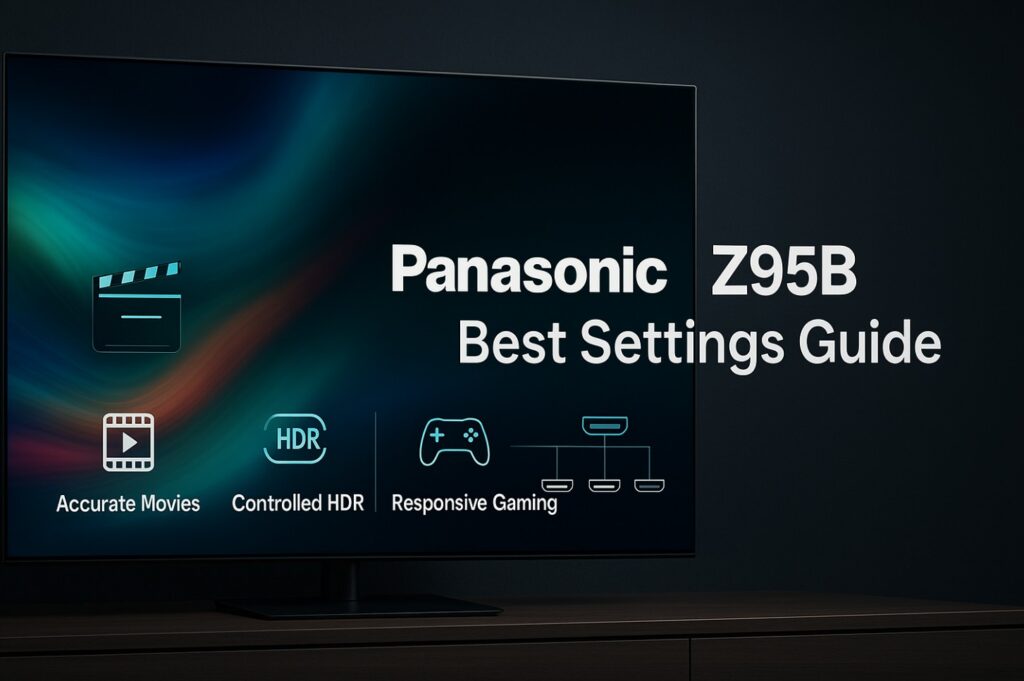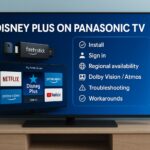Panasonic Z95B best settings is the guide you want if you’ve just unboxed this flagship “Primary RGB Tandem” OLED and want accurate movies, bright but controlled HDR, and responsive gaming without artifacts. In a few minutes you’ll lock in film‑grade picture modes, dial brightness the right way for bright rooms, and map your HDMI ports to consoles, PC, and AVR so everything “just works.” 🌟
Context you can trust: Z95B uses Panasonic’s Primary RGB Tandem OLED panel with ThermalFlow cooling, supports Dolby Vision IQ and HDR10+ Adaptive, and offers up to 144Hz with VRR/FreeSync/G‑Sync via HDMI 2.1 (two high‑bandwidth inputs). It runs Fire TV OS and carries a powerful Technics‑tuned multi‑speaker system.
Brightness & HDR — claims vs rounded independent measurements
The Z95B can be extremely bright for an OLED when you let it stretch its legs, but accurate modes intentionally pull it back. Use this table to understand what you’re choosing:
| Mode / Metric | Manufacturer claims | Rounded independent measurements* | What to expect |
|---|---|---|---|
| HDR peak highlights (65″) | “Significantly increased brightness” with Primary RGB Tandem + ThermalFlow | ~2,100–2,250 nits peak (best case with brighter picture presets), ~900–1,100 nits in reference‑accurate modes | Bright specular highlights in optimized HDR; Filmmaker stays restrained for accuracy |
| Full‑field HDR (10%→100%) | Not quoted | High sustained vs prior gen; tandem + cooling maintains luminance better over time | Less clipping and better ABL behavior in long HDR scenes |
| SDR (accurate 100‑nit base) | Not quoted | Tracks reference easily; room light raises target if you enable Intelligent Sensing | Day vs night behavior you control via Sensing/IQ |
* Rounded from multiple reputable publications’ instrumented tests; exact numbers vary by size, firmware, and settings.
How to use this: If you watch in a sunlit room, consider Dolby Vision IQ or HDR10+ Adaptive (they leverage the ambient sensor to keep detail visible), then tame color/contrast gently (see below). For a dim cinema vibe, Filmmaker Mode remains reference‑accurate by design. 🎬
Design & Build Quality
Sturdy chassis, integrated 360° Soundscape Pro speaker array (front line‑array, side/up‑firing plus woofers), and a swivel stand on 65/55″ sizes. It’s thicker than ultra‑slim OLEDs because of the serious audio hardware—and that’s a good trade if you want fewer boxes under the TV.
Panel Technology Explained
Panasonic’s Primary RGB Tandem OLED with ThermalFlow cooling increases brightness and color volume versus standard single‑stack OLED. The cooling solution also helps sustain luminance during long HDR scenes, not just in short peaks. That’s why Z95B can push past the ~2,000‑nit mark in optimized modes while keeping gradations clean.
Color Accuracy & Picture Processing
- Processor: HCX Pro AI MK II aims for neutral EOTF and skin‑tone fidelity.
- Dolby Vision choices: Vivid, IQ, Dark, Game. For accuracy, stick to DV Dark in a dark room; choose IQ in mixed/bright light.
- HDR10+: choose HDR10+ Adaptive in bright rooms, HDR10 for fixed mastering in a dark room.
- Disable heavy edge enhancement; keep noise reduction Low/Off for 4K discs and high‑bitrate streams.
Motion Handling & Refresh Rates
- Panel supports up to 144 Hz; consoles use 60/120 Hz, PC can use 120/144 Hz via HDMI 2.1.
- For films at 24p, leave interpolation off (Filmmaker/True Cinema) to avoid soap‑opera effect. For live sports, enable a mild motion setting.
- PC gamers: 120/144 Hz + VRR (with G‑Sync‑compatible / FreeSync Premium).
Gaming Performance
Use Game Mode Extreme. Then open Game Control Board:
- VRR: On (consoles & PC).
- Black Equalizer / Gradation Preferred: adjust per title; start neutral to avoid crushing detail.
- HDR Tone‑Mapping: prefer platform‑guided (HGIG‑style) when available; if a game looks too dim, try Panasonic’s tone‑mapping On and raise HDR Brightness a notch—avoid blowing out specular detail.
- Input lag: very low; two HDMI 2.1 ports carry the full high‑refresh capability.
Smart Platform & UX
The Z95B ships with Fire TV. You get broad app coverage, Prime Video Calibrated Mode, Netflix Adaptive Calibrated Mode, Dolby Vision IQ/HDR10+ Adaptive hooks, and Alexa voice. If you’re all‑in on Apple, enable AirPlay for casting.
Audio & Connectivity (Port‑by‑port I/O map)
| Port | Spec / Role | Best use |
| HDMI 1 | HDMI 2.1 (VRR/HFR up to 144 Hz) | PC or PS5/XSX (4K120/144) |
| HDMI 2 (eARC) | HDMI 2.1 + eARC | Connect AVR/soundbar here for lossless audio |
| HDMI 3 | HDMI (2.0‑class features) | Apple TV 4K / streaming stick |
| HDMI 4 | HDMI (2.0‑class features) | Secondary console/Blu‑ray |
| USB x3 | 1× USB 3.0 + 2× USB 2.0 | PVR/HDD, service media |
| Ethernet | LAN | Stable streaming/updates |
| Optical Out | S/PDIF | Legacy audio gear |
| Headphone/Sub | 3.5 mm (switchable to sub) | Headphones or active sub |
Notes: ALLM on all inputs; VRR/HFR/FreeSync/G‑Sync on HDMI 1 & 2; keep eARC on HDMI 2 even if your AVR also supports 2.1. Use certified Ultra High Speed HDMI cables.
Step‑by‑step: Panasonic Z95B best settings (day & night)
Movies (dark room, accuracy first)
- Picture Mode: Filmmaker Mode
- Intelligent Sensing: Off (dark room)
- Contrast/Brightness: leave default; HDR Tone‑Mapping: Off/Reference behavior
- Color Temp/White Balance: Warm (default accurate) → fine‑tune only if you own a meter
- Sharpness/Noise Reduction: 0 / Off (4K), Low for poor streams
- Motion: Off or Minimum (avoid soap‑opera)
- Ambient Light Sensor: Off (we’re in a dark room)
- HDR Formats: Auto (DV IQ/Dark and HDR10+ available per content)
Streaming HDR in bright rooms (pop without crush) ☀️
- Picture Mode: Dolby Vision IQ (or HDR10+ Adaptive when DV absent)
- Intelligent Sensing: On
- HDR Brightness: +1 if highlights look muted in heavy daylight
- Color Remaster/Enhancers: keep Low to avoid oversaturation
- Motion: Minimum for sports only
- Energy Saving: Off or Low (prevents auto‑dimming of HDR on some feeds)
Gaming (PS5/XSX/PC, 120/144 Hz) 🎮
- Picture Mode: Game Mode Extreme
- VRR: On (Console/PC)
- HDR Tone‑Mapping: Prefer platform‑guided; if a title looks too dim, enable TV tone‑mapping and raise HDR Brightness minimally
- 4K 120/144 Hz: Enable on console/PC; set input to Enhanced/2.1 if prompted
- Black Frame Insertion (BFI): Off for 120/144 Hz (flicker)
- Gradation Preferred: 0 or +1 to smooth banding at cost of slight blur
Thermal Design & Longevity
ThermalFlow helps sustain luminance and disperses heat; tandem architecture reduces stress per sub‑pixel at a given brightness. Still use common‑sense OLED care: vary content, enable screen protection, keep static HUDs in check for marathon sessions.
Real‑World Impressions
With the right mode, Z95B swings from reference‑accurate cinema to daylight‑capable HDR that pops without cartoonish color. Fire TV is busy, but it’s fast; audio is unusually full for an integrated system, meaning many living rooms won’t need a soundbar. If you demand the leanest UI, an external streamer on HDMI 3/4 is a clean fix. 🔊
Common Mistakes to Avoid ⚠️
- Forcing Vivid for HDR movies; it lifts EOTF and clips highlights.
- Plugging your AVR into HDMI 1; eARC lives on HDMI 2.
- Leaving Motion on High for films; you’ll get soap‑opera effect.
- Using heavy Noise Reduction on 4K discs; it erases texture.
FAQ
Does Panasonic Z95B support 144 Hz for gaming?
Yes. The panel supports up to 144 Hz via HDMI 2.1 on inputs 1 & 2 (VRR/HFR). Consoles top at 120 Hz; PC can use 144 Hz.
Which is better on Z95B in a bright room: Dolby Vision IQ or HDR10+ Adaptive?
Both adapt to ambient light. Use Dolby Vision IQ when the app delivers DV; use HDR10+ Adaptive otherwise. Try IQ first; switch if a title looks off.
What are the Panasonic Z95B best settings for movies?
Filmmaker Mode, Intelligent Sensing Off (dark room), motion Off/Min, sharpness 0, NR Off for 4K, accurate white balance (Warm). For bright day viewing, use DV IQ or HDR10+ Adaptive. (See step‑by‑step above.)
How many HDMI 2.1 ports does Z95B have?
Four HDMI inputs total; two carry the full 2.1 gaming feature set (VRR/HFR/FreeSync/G‑Sync). eARC is on HDMI 2.
Why does Filmmaker Mode look dimmer than other presets?
Because it prioritizes reference accuracy. If you want more punch in daylight, try Dolby Vision IQ or raise HDR Brightness slightly.
Is the built‑in audio good enough to skip a soundbar?
For many rooms, yes—the 360° Soundscape Pro system is unusually capable (front array + side + up‑firing + woofers).
Final Verdict
Z95B’s strength is choice: Filmmaker for cinema‑grade accuracy at night, IQ/Adaptive to keep HDR lively in daylight, and Game Mode Extreme for silky 120/144 Hz play. Use the table and I/O map here, and you’ll get the “bright when you need it, faithful when you want it” experience that makes this Panasonic special. ✨
Useful links
LG G5 vs Samsung S95F vs Panasonic Z95B (65-Inch)
https://tvcomparepro.com/lg-g5-vs-samsung-s95f-vs-panasonic-z95b/
Best Panasonic TVs for Movies and Sports – Cinematic Experience at Home
https://tvcomparepro.com/best-panasonic-tvs-movies-sports-2025/


